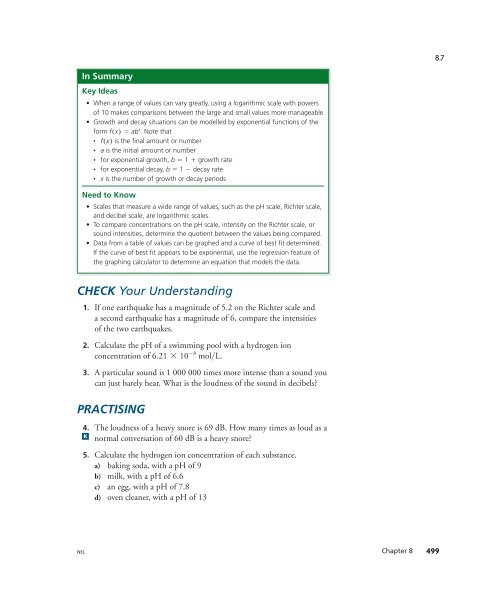Chapter 8
Chapter 8
Chapter 8
You also want an ePaper? Increase the reach of your titles
YUMPU automatically turns print PDFs into web optimized ePapers that Google loves.
8.7<br />
In Summary<br />
Key Ideas<br />
• When a range of values can vary greatly, using a logarithmic scale with powers<br />
of 10 makes comparisons between the large and small values more manageable.<br />
• Growth and decay situations can be modelled by exponential functions of the<br />
form f(x) 5 ab x . Note that<br />
• f(x) is the final amount or number<br />
• a is the initial amount or number<br />
• for exponential growth, b 5 1 1 growth rate<br />
• for exponential decay, b 5 1 2 decay rate<br />
• x is the number of growth or decay periods<br />
Need to Know<br />
• Scales that measure a wide range of values, such as the pH scale, Richter scale,<br />
and decibel scale, are logarithmic scales.<br />
• To compare concentrations on the pH scale, intensity on the Richter scale, or<br />
sound intensities, determine the quotient between the values being compared.<br />
• Data from a table of values can be graphed and a curve of best fit determined.<br />
If the curve of best fit appears to be exponential, use the regression feature of<br />
the graphing calculator to determine an equation that models the data.<br />
CHECK Your Understanding<br />
1. If one earthquake has a magnitude of 5.2 on the Richter scale and<br />
a second earthquake has a magnitude of 6, compare the intensities<br />
of the two earthquakes.<br />
2. Calculate the pH of a swimming pool with a hydrogen ion<br />
concentration of 6.21 3 10 28 mol>L.<br />
3. A particular sound is 1 000 000 times more intense than a sound you<br />
can just barely hear. What is the loudness of the sound in decibels?<br />
PRACTISING<br />
4. The loudness of a heavy snore is 69 dB. How many times as loud as a<br />
K<br />
normal conversation of 60 dB is a heavy snore?<br />
5. Calculate the hydrogen ion concentration of each substance.<br />
a) baking soda, with a pH of 9<br />
b) milk, with a pH of 6.6<br />
c) an egg, with a pH of 7.8<br />
d) oven cleaner, with a pH of 13<br />
NEL <strong>Chapter</strong> 8 499


